The Internet has come a long way from its origins as an electronic messaging system for military personnel and researchers in the physical sciences. In recent years, the Internet has blossomed into a global communications system capable of bringing people of common interests together from all parts of the world. In a field as specialized as synoptic source criticism, the Internet promises to be a useful medium for exchanging ideas among those interested in the Synoptic Problem, ranging from the leading theorists and professors to students and devoted amateurs. While the Internet can never replace a well-stocked library nor substitute for high quality peer-reviewed books and journals, the Internet includes a variety of resources that supplements the traditional research tools. Two of the most important Internet resources for researchers of the Synoptic Problem are home pages on the World Wide Web and electronic mailing lists.
A home page on the World Wide Web is an electronically published document accessible to software called a “browser” such as the Netscape Navigator or the Microsoft Internet Explorer. To visit a home page, the user enters the address of the page, called the URL (Uniform Resource Locator), into the browser. In response, the browser retrieves the page from the Internet and displays the page. Web pages are typically formatted in a markup language called HTML and often include text, embedded graphics, and hypertext links. Hypertext links are a significant feature of web documents, because they enable the user to access another page on the Web quickly by a simple click of the button.
Electronic mailing lists are coordinated discussion groups in which people exchange messages by electronic mail. Typically, a person signs up with a mailing list by submitting a subscription request to a specialized software program, responsible for managing the mailing list. Once subscribed, the user receives all messages sent to the list. Some mailing lists are closed so that only subscribed members can post to the list, but other mailing lists allow anyone to reach all the recipients of the list. Many mailing lists have their own home page, which explains the purpose of the list, how to subscribe to the list, the proper list protocols, and hypertext links to related web sites.
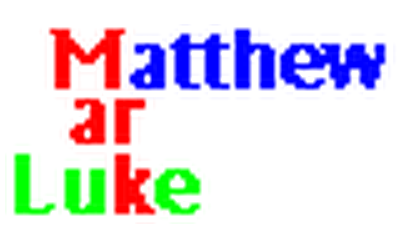 The Synoptic Problem Website (formerly the Synoptic Problem Home Page) is established to survey proposed solutions to the Synoptic Problem and be a clearinghouse of materials related to its resolution. This web site is located at the following URL: http://www.hypotyposeis.org/synoptic-problem/. The Synoptic Problem Website comprises reference materials for investigating various facets of the Synoptic Problem. The most ambitious of these reference materials is a four-color Greek synopsis, which is designed to highlight the agreements and differences in wording between Matthew, Mark and Luke. A parallel synoptic table exhibits the order and arrangement of the pericopes belonging to the Synoptic Gospels. Other resources provided by the Synoptic Problem Website include a brief overview of the Synoptic Problem, an annotated bibliography, and a chronology of attempts to resolve the Synoptic Problem.
The Synoptic Problem Website (formerly the Synoptic Problem Home Page) is established to survey proposed solutions to the Synoptic Problem and be a clearinghouse of materials related to its resolution. This web site is located at the following URL: http://www.hypotyposeis.org/synoptic-problem/. The Synoptic Problem Website comprises reference materials for investigating various facets of the Synoptic Problem. The most ambitious of these reference materials is a four-color Greek synopsis, which is designed to highlight the agreements and differences in wording between Matthew, Mark and Luke. A parallel synoptic table exhibits the order and arrangement of the pericopes belonging to the Synoptic Gospels. Other resources provided by the Synoptic Problem Website include a brief overview of the Synoptic Problem, an annotated bibliography, and a chronology of attempts to resolve the Synoptic Problem.
The most prominent feature of the Synoptic Problem Website is its survey of various solutions to the Synoptic Problem. Each proposed solution is displayed with a graphical sketch that diagrams the relationships between the Synoptic Gospels and any hypothetical sources. In addition, each hypothesis is briefly explained with a citation to a leading proponent. The hypotheses are organized into six sections of related solutions.
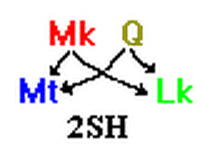 The first section is dedicated to variants of the popular Two Source Hypothesis, which holds that both Matthew and Luke are dependent on Mark and a hypothetical source called Q.[1]
The first section is dedicated to variants of the popular Two Source Hypothesis, which holds that both Matthew and Luke are dependent on Mark and a hypothetical source called Q.[1]
The second section of the survey is concerned with the Two Gospel Hypothesis,[2] which postulates that Luke used Matthew and Mark conflated both Matthew and Luke.[3]
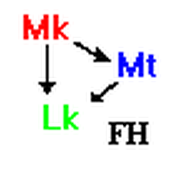 The Farrer Hypothesis, which accepts Markan priority but dispenses with Q in favor of Luke’s use of Matthew,[4] is the subject of the third section.
The Farrer Hypothesis, which accepts Markan priority but dispenses with Q in favor of Luke’s use of Matthew,[4] is the subject of the third section.
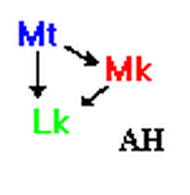 The topic of the fourth section is the oldest solution to the Synoptic Problem, the Augustinian Hypothesis,[5] which calls for successive dependence in the order of Matthew, Mark, and Luke.
The topic of the fourth section is the oldest solution to the Synoptic Problem, the Augustinian Hypothesis,[5] which calls for successive dependence in the order of Matthew, Mark, and Luke.
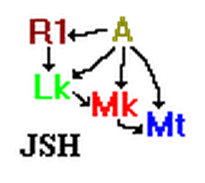 The survey’s fifth section is devoted to solutions in which Luke is prior to the other Synoptic Gospels. Of the Lukan priority hypotheses, the most active is the Jerusalem School Hypothesis, which owes its origin to Robert L. Lindsey.[6] This hypothesis places much emphasis on the Hebrew background of the Gospels and argues for dependence in the order of Luke, Mark, and Matthew, with all three being dependent on a shared, hypothetical source. The sixth and final section describes theories that are difficult to classify such as the recent Greek Notes (Logia Translation) Hypothesis by Brian E. Wilson. Brian Wilson believes that each of the Synoptic Gospels independently used a Greek notebook, which is a translation of Semitic notebooks. These notebooks contain many of the events and sayings found in Matthew, Mark and Luke.
The survey’s fifth section is devoted to solutions in which Luke is prior to the other Synoptic Gospels. Of the Lukan priority hypotheses, the most active is the Jerusalem School Hypothesis, which owes its origin to Robert L. Lindsey.[6] This hypothesis places much emphasis on the Hebrew background of the Gospels and argues for dependence in the order of Luke, Mark, and Matthew, with all three being dependent on a shared, hypothetical source. The sixth and final section describes theories that are difficult to classify such as the recent Greek Notes (Logia Translation) Hypothesis by Brian E. Wilson. Brian Wilson believes that each of the Synoptic Gospels independently used a Greek notebook, which is a translation of Semitic notebooks. These notebooks contain many of the events and sayings found in Matthew, Mark and Luke.
The Synoptic Problem Website also contains hyperlinks to related web sites, including A Synoptic Gospels Primer by Prof. Mahlon H. Smith of Rutgers University, Mark Without Q by Dr. Mark Goodacre of the University of Birmingham, the Two Gospel Hypothesis Home Page sponsored by Prof. Thomas R. W. Longstaff of Colby College, and the Jerusalem School’s Jerusalem Perspective Online.
The Synoptic Gospels Primer, at http://religion.rutgers.edu/nt/primer, is developed by Mahlon Smith mainly from the perspective of the Two Source Hypothesis and is intended to go “beyond the usual superficial discussion of the synoptic problem.” In this respect, it certainly succeeds by presenting a detailed source critical analysis of several pericopes in accordance with the Two Source Hypothesis, the Griesbach or Two Gospel Hypothesis, the Farrer Hypothesis, and the Augustinian Hypothesis. This site also includes an informative glossary of important terms and concepts in synoptic source criticism.
Mark Without Q is the title of Mark Goodacre’s web site, which is located at http://www.bham.ac.uk/theology/q and argues forcefully for Markan Priority but against the hypothetical Q document. Among Mark Goodacre’s materials are an informative list of frequently asked questions (FAQ) about why it is preferable to conclude that Luke used Matthew not Q, and web accessible copy of Austin Farrer’s seminal essay, “On Dispensing with Q.”[7]
Thomas R. W. Longstaff is the maintainer of the Two Gospel Hypothesis Home Page, found at http://www.colby.edu/rel/2gh. Although this site is still very much “under construction,” it contains a multicolor synopsis developed by David Peabody, designed to elucidate Mark’s conflation of Matthew and Luke, and a bibliography of prominent proponents of the Two Gospel Hypothesis.
Being the Internet presence of the Jerusalem School of Synoptic Research, Jerusalem Perspective Online is a web site that covers all aspects of the Synoptic Gospels, including the Synoptic Problem, with special emphasis on the Hebrew roots behind the Gospels. The web site contains numerous articles, biographies and links to other sites on the World Wide Web.
The Synoptic Problem Home Page also provides subscription information about scholarly mailing lists that have featured active discussions of the Synoptic Problem. The most pertinent of these mailing lists is Synoptic-L, which was started in February 1998 by Mark Goodacre of the University of Birmingham. Synoptic-L is an academic conference specifically dedicated to a critical, scholarly study of the Synoptic Problem and to exegesis of the Synoptic Gospels. Knowledge of Greek is a recommended plus for participating.
The remaining mailing lists mentioned by the Synoptic Problem Website, Xtalk, Ioudaios, and B-Greek, while not specifically intended for the Synoptic Problem as Synoptic-L, can shed light on collateral aspects of the Synoptic Problem. Spun off from Crosstalk, a mailing list sponsored by HarperCollins Publishers to supplement an email debate between John Dominic Crossan, Marcus Borg and Luke Timothy Johnson, the Xtalk mailing list is mostly devoted to a scholarly quest for the Historical Jesus. Since the Gospels constitute the primary documentary sources for the life of Jesus, questions as to their origins have been welcomed and debated. The Ioudaios list is dedicated to discussing Hellenistic Judaism, especially the works of Josephus and Philo. One of the oldest mailing lists in biblical studies, Ioudaios has extensive archives involving debates about Q and other aspects of the Synoptic Problem. While higher critical topics such as the Synoptic Problem are not the focus of the biblical Greek mailing list, B‑Greek is a very helpful place for investigating the meaning of the Greek text of the Bible, including, of course, the Synoptic Gospels.
Like many documents on the Internet, the Synoptic Problem Website is not static but evolving. It will continue to be updated from time to time in order to keep up with the latest developments on the Internet and the World Wide Web relating to synoptic source criticism. Its maintainer, Stephen Carlson, will gratefully accept any comments or suggestions for improving the Synoptic Problem Website, preferably by email.
- [1] The most influential treatment in the English language remains B. H. Streeter, The Four Gospels: A Study of Origins (London: Macmillan, 1924), although some arguments are now considered obsolete. A well-written, modern explanation of the Two Source Hypothesis suitable for textbook use is R. H. Stein, The Synoptic Problem: An Introduction (Grand Rapids, MI: Baker Books, 1987). ↩
- [2] The “Two Gospel Hypothesis” was coined by its adherents during the Cambridge Conference of 1979 to replace the more usual term, “Griesbach Hypothesis.” See New Synoptic Studies: The Cambridge Gospel Conference & Beyond (ed. W. R. Farmer; Macon, GA: Mercer, 1983) xxxiv. ↩
- [3] W. R. Farmer, The Synoptic Problem: A Critical Analysis (2d ed.; Dillsboro, NC: Western North Carolina Press, 1976) is largely responsible for its twentieth-century revival. ↩
- [4] The seminal essay is A. Farrer, “On Dispensing with Q,” in Studies in the Gospels (R. H. Lightfoot Festschrift; ed. D. E. Nineham; Oxford: Blackwell, 1955) 55–88, although J. H. Ropes,The Synoptic Gospels (Cambridge, MA: Harvard University Press, 1936), anticipated at least its broad outlines. The most comprehensive treatment of this hypothesis is M. D. Goulder, Luke: A New Paradigm (JSOTSup 20; Sheffield: JSOT Press, 1989). ↩
- [5] The two strongest defenders of the Augustinian Hypothesis in the twentieth century are B. C. Butler, The Originality of St. Matthew: A Critique of the Two-Document Hypothesis (Cambridge: University Press, 1951) and J. Wenham, Redating Matthew, Mark & Luke: A Fresh Assault on the Synoptic Problem (Downers Grove, IL: InterVarsity, 1992). ↩
- [6] See, especially, R. L. Lindsey, “A Modified Two-Document Theory of the Synoptic Dependence & Interdependence,” NovT 6 (1963), 239–63 and idem, A Hebrew Translation of the Gospel of Mark: Greek-Hebrew Diglot with English Introduction (2nd ed.; Jerusalem: Dugith, 1973). ↩
- [7] See supra n. 4. ↩






























































































